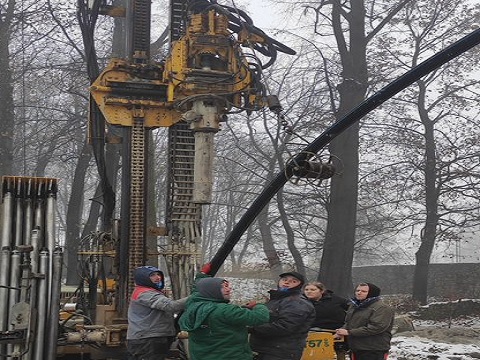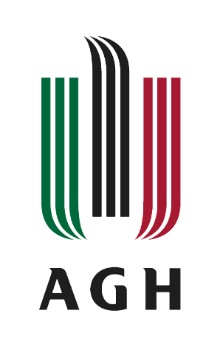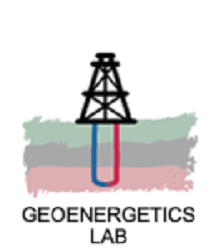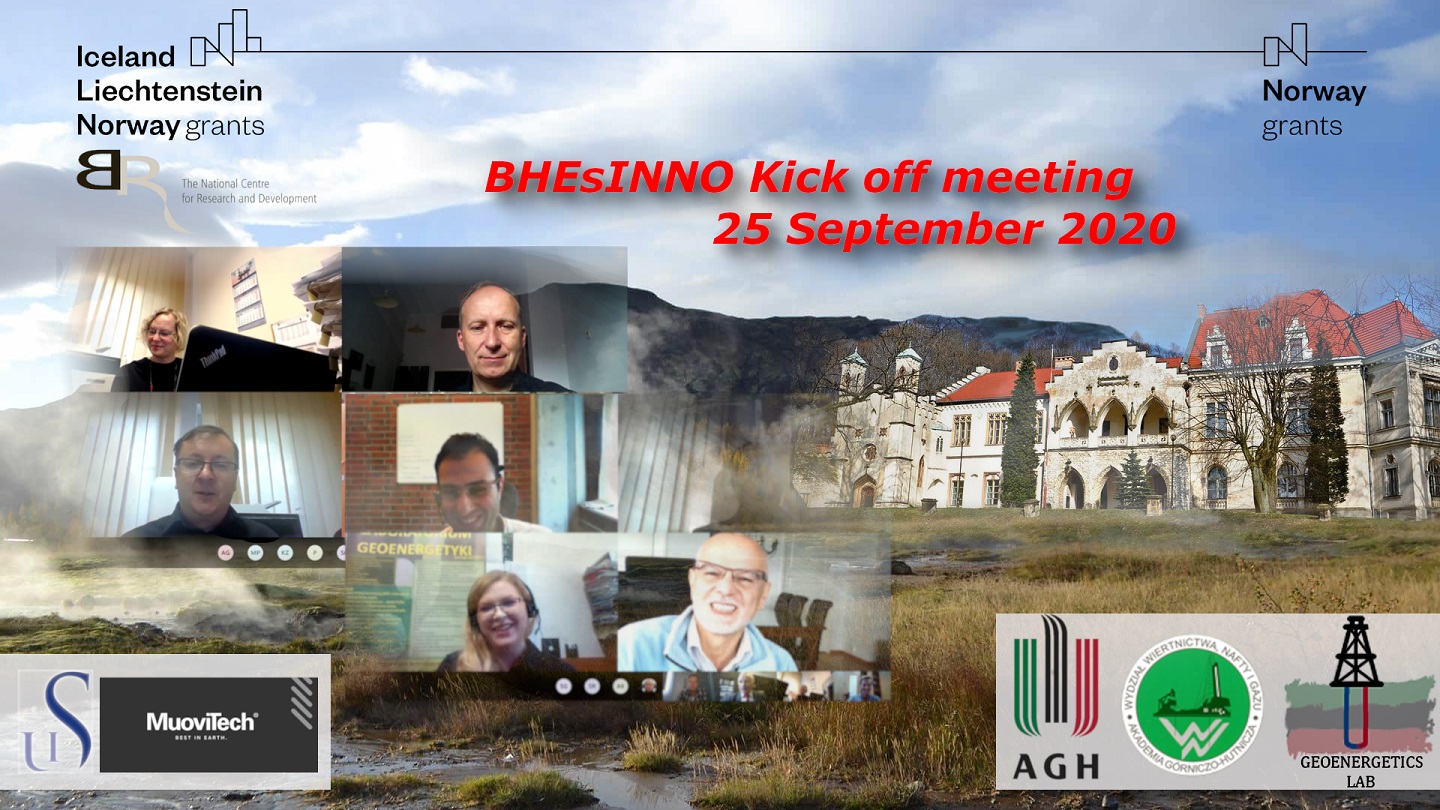Project Abstract
Underground Thermal Energy Storage (UTES) is a particularly good way of providing thermal comfort in northern countries (e.g. Norway and Sweden) as well as in central and eastern Europe (e.g. Poland and Ukraine). The project involves development of innovative structures of Borehole Heat Exchangers (BHEs). Structures tested as a part of the project will aim to maximize the energy effect (which is defined as a unitary power obtained in BHE, in Watt per meter). Innovative constructions include the pipe system in the borehole. New composite coaxial pipes system will be developed. Coaxial constructions will be analyzed and compared to the traditional, U-tube based ones. The coaxial construction give possibilities use it in a boreholes with greater depth than U-pipe design. Research methodology is based on mathematical modelling of a individual BHEs as well as fields consisting of multiple BHEs, taking into account their interference. Modelling will be verified by in situ tests on created BHEs. It is expected to conduct Thermal Response Tests (TRT) on every borehole. Next innowation is TRT results interpretation. TRT results will be interpreted using three methods. Additionally, thermal conductivity test will be conducted on minimum three Borehole Heat Exchangers. It is new test of BHEs. Very important innovation for BHEs fields making in the future is optimization of drilling technology parameters. New methodology will be developed for in situ application - on the begginning of BHEs drilling with large number of boreholes. Promotion of research results via conferences, scientific journals, monograph and the Internet is expected. PhD thesises will be prepared, also many MSc thesises. Mentoring will be executed.
Project objectives
Overall objective
The project has many goals related to research and implementation in the field of heat recovery from the rock mass and its storage (regeneration of resources) via borehole heat exchangers (Śliwa and Rosen 2015). The overall goal of the project is to protect the atmosphere against combustion products of traditional fossil fuels. The goal will be achieved due to the improvement in energetic and economic efficiency of both heating and heating and cooling systems based on geothermal heat pumps and borehole heat exchangers.
Specific objectives
- The goal is to develop a computer model of heat transport phenomena in the borehole heat exchanger, taking into account all important phenomena occurring in the borehole together with its equipment, in the rock mass, and on its upper surface. Identification and quantification of performance parameters for all practical BHE applications. Analysis of such phenomena on the basis of temperature distribution at different depths will allow to decide which of the factors are the most important for this type of research and which should be considered. Determining the temperature field and the average seasonal temperature of the rock mass is a basic goal and allows to estimate the thermal potential of the rock mass based on the best heat exchanger design and optimal strategies for a large number of them (BHEs field). Model development and problem solving is key to optimizing the BHE system. The goal is to test different strategies for borehole heat exchanger design and distribution in a limited three-dimensional space. The model will be a tool for optimizing the design of a borehole heat exchanger with a centric column by checking BHE efficiency. Proven vertical borehole heat exchanger models and simulation models will be used. The developed model will contain innovative and optimal solutions for a single BHE, as well as for BHEs fields.
- The purpose of the research is to develop an inner coaxial pipe for use in BHEs of greater depths. Land restrictions, especially in urban areas, tend to increase the depth of BHEs. Traditional U-tubes used in BHEs in boreholes of greater depths are not optimal due to heat loss and heat carrier flow resistance. Coaxial BHE is dedicated to greater depths precisely because of the limitation of heat losses and pressure losses associated with carrier circulation. The key pipe parameters of the coaxial exchanger are: properly selected thermal conductivities of the outer and inner pipes, mechanical strength, and the way of running it into the boreholehole during the creation of BHE. The outer pipe should have the highest possible thermal conductivity, while the inner pipe must thermally insulate the heat carrier stream circulating in it. Due to the depth of the pipe, they must have sufficiently high mechanical strength. Development of BHE with specific thermal & mechanical material charactreistics which mentioned above is a part of the research prupose. Additionally, the outer pipe can not be coiled therefore it should be assembled in the site. Developing of adhesive for bonding joints of the outer pipe under water and on wet surface is also part of the research objective.
- The goal is to develop a simple method for optimizing drilling parameters, which will reduce the cost of performing BHEs. The parameters are: the rotational speed of the drill bit, pressure on the bit and air pressure in the rotary percussive method. When implementing BHEs field, the first holes will be drilled at various parameters, which will contribute to determining their optimal values for given geological conditions (rock hardness, aquifers, tendency to tilt from the axis of the borehole). For the cost of drilling, the most important parameters are drilling speed and drill bit wear. The listed interdependencies will be taken into account in the developed field method and presented for use of companies drilling BHEs.
- The aim of the project is also to develop business and marketing strategies enabling the introduction of new technology (coaxial BHE) for implementation. In this area, i.a. organization of conferences for drilling companies in Poland and for various levels of administrative staff is planned. The goal is to increase technological readiness from level 2 to level 6.
Description of the consortium
Applicant 1 – AGH UST in Krakow, Poland. AGH UST is one of 10 research universities (on 3rd place) in Poland (highest level in the Polish system according to the Ministry of Science and Higher Education). AGH UST is a university of new technologies. Number of branches of science at AGH UST is 62 including energy, its resources, and mining. Total number of students (as of 31st December 2018) is 27 508 (full-time students: 20 412 [including foreign students: 618], part-time students: 3 497, doctoral students: 1040 [including foreign students: 37], postgraduate students: 2 559.
Total number of staff (as of 31st December 2018) is 4056 (teaching and research staff: 1845, full professors: 136, associate professors: 271 (including associate professors with title: 65), assistant professors: 1071 (including assistant professors with postdoctoral qualifications: 252), assistants: 366. The activities of Faculty of Drilling, Oil and Gas (FDOG) AGH UST, in the extent relevant to the project’s application, concerns the development of latest techniques and technologies: deposits’ prospecting and development, prospecting and modelling of deposits’ geological structure, borehole design, optimisation of technological drilling parameters, development of mud and slurry formulas, mathematical modelling and computer simulation of the raw materials deposits exploitation, exploitation of natural gas deposits and CO2 storage. In recent years more than 30 projects were conducted on FDOG AGH UST, funded by various sources and programmes i.a. Blue Gas, Gekon, POIG - action 1.3, H2020, Polish-Norwegian Research Cooperation, NFOŚIGW, the Ministry of Foreign Affairs projects, European Institute of Innovation & Technology EIT projects, and European Space Agency (ESA) projects. 14 results of scientific research or development works were implemented, 16 patents authored by employees were obtained.
The core of AGH UST (PP) research team is concentrated in the Laboratory of Geoenergetics (LG), on the Faculty of Drilling, Oil and Gas (FDOG). These are: Prof. Tomasz Śliwa (PI, FDOG), Prof. Andrzej Gonet (FDOG), Prof. Marek Jaszczur (Faculty of Energy and Fuels), Prof. Leszek Pająk (Faculty of Geology, Geophysics and Environmental Protection), PhD Aneta Sapińska-Śliwa (FDOG), PhD Albert Złotkowski (FDOG), PhD Wojciech Teper (FDOG), 8 Doctoral Students, several Master's Students, several Engineering Students, a representative of the Task Service Team from the Division of Chancellor AGH UST, 2 individuals for the project’s administrative service handling. The team has extensive research experience in the field of geothermal energy as an interdisciplinary science. LG FDOG AGH UST has been operating for 12 years. As part of its operations, it was possible to create a laboratory with multiple research stations, owning specialized software, with two BHEs fields consisting of 19 BHEs, each of a different design. Among them, a coaxial BHE with the possibility of replacing the inner column. During team’s 12 years of operations, a number of graduates has been educated, with a particular focus on drilling. Postgraduate studies (Geoenergetics and Geoengineering) and a new specialty on MSc studies (Geoengineering and Geothermics) were created on FDOG. Many national and international research projects have been carried out. In 2017 project "Geothermal energy - a basis for low-emission heating, improving living conditions and sustainable development – preliminary studies for selected areas in Poland" was co-implemented. The project was funded by the EEA Financial Mechanism 2009-2014 under the Bilateral Cooperation Fund – the so-called Norwegian Grants.
Other chosen grants:
- "Analysis of the possibilities of using wells as borehole heat exchangers on the example of the Iwonicz wells", research project, project No. PB 1705 / T12 / 2001/20, KBN grant,
- "Methodology and technology of obtaining useful geothermal energy from a single borehole", contractor, implementation of the KBN target project, research project, project No. 8T10B049 98C/3844,
- "Development of an integrated system of borehole heat exchangers and solar collectors in the aspect of improving the efficiency of heat management in rock-mass", research project, NCN grant, registration number: N N524 353738,
- "Strengthening the self-governments of the Transcarpathian region in the field of modern management of municipal services and energy saving through comprehensive use of geothermal energy", international project financed by the Ministry of Foreign Affairs of the Republic of Poland,
- "Rationalization of energy management in typical public buildings of the city and Oblasti Ivano-Frankivsk", international project financed by the Ministry of Foreign Affairs of the Republic of Poland,
- "Optimization of drilling parameters, including the selection of drilling technologies, tools, drilling fluids and cementing of vertical and horizontal wells for the exploitation of shale gas" OPTIDRILLTEC, NCBiR grant, under the Blue Gas Program - Polish Shale Gas, Currently, the team updates guidelines for Polish drilling companies regarding the correct design and creation of BHEs.
Applicant 2 – MuoviTech Polska, Niepołomice, Poland. MuoviTech is a global leader of innovative products and systems for geothermal energy with own production plants in Sweden, Finland, Poland, Holland, England and Norway. We create future thanks to our knowledge workers. MuoviTech was started in 2002, although it is a small international group but it stands for speed, informality and innovative. To be agile and at the same time to be nimbleness and responsiveness, special structure in the organization is a must. The mother company is located in Sweden and since we are a small group we have also concentrated some departments such as R&D and quality assurance on the mother company and make operation with cross functional team in each country. Currently our R&D are intensively working with another European project through the functional team with our colleagues in Finland. Know how is the most important asset in MuoviTech, so far two patents (Ojala et al. 2009) and (Kalantar & Skrifvars, 2014); has been filed; former relates to the shape of the collector commercially known as TurboCollector while, latter involving enhanced thermally-conductive PE composite. We were proudly member of two technical committees to create and share our knowledge within Annex 27 and European standard CEN TC451. Continues innovation in this technology needs huge amount of field test known as thermal response test. Since MuoviTech focuses on developing on BHEs it is important to have its own filed test, meanwhile in many part of European countries grouting is mandatory so boreholes are used just one time for the research, however, this is not the case for R&D in MuoviTech group since is not mandatory in Sweden. Therefore we have this opportunity to use same geological condition several times with different BHE in our test boreholes in R&D department in Sweden. This is also another reason for centralizing our research activities in Sweden. Although we are young in this business but the number the academic publication shows our enthusiastic into knowledge creation.
Applicant 3 – University of Stavanger, Norway. The University of Stavanger (UiS) is a science- and technology-based university located in Stavanger, which is the oil and energy capital in Norway. UiS has about 12,000 students and 1,700 administration, faculty and service staff. UiS is a world-class facility in the field of energy and petroleum science. UiS is an experienced participant of international projects and participated in more than 20 FP7 projects. UiS is currently involved in 8 Horizon 2020 projects, EEA projects and nationally funded projects. In this BHEsINNO project, the Department of Energy and Petroleum Engineering covers all relevant energy-related research fields. The department head is Øystein Arild, who is UiS responsible for this project. The key research areas withing the department are energy, drilling, production, reservior and well-integrity. The energy group at the depratment has extensive experience in several EU and Nationally funded projects such as H2-IGCC (Low emission gas turbine technology for hydrogen-rich Syngas), ENSEA (European North Sea Energy Alliance), Sustainable energy and environment solutions: technology and policy, Road map for decarbonisation of Indian energy system: exploring innovative solutions and Bio-CHP-Monitor (Theoretical and experimental investigation of biogas fueled technologies using advanced and intelligent modelling and monitoring tools). The group is currently leading two work packages in two EU projects, namely ENSYTRA on energy system transition and NextMGT on next generation of distributed energy systems. Energy group is also heading geothermal energy program area at UiS, under which several research activities sheltering the main dimensions of geothermal energy, from underground resource to production technologies on the surface are under development. The key experts in this project will be Prof. Mohsen Assadi and Dr. Homam Nikpey. Their research has focused on clean technologies, energy system integrtaion, smart energy systems, techno-economic optmization, geothermal energy and knowledge transfer from petroleum to renewable energy sector.
Milestones
Physics based simulation of BHE and ground source concepts, challenges and opportunities
-
MS1-1 Time left: doneBHE Mathematical model. The mathematical model of Borehole Heat Exchangers and sourunding ground source is developed. The model is base on CFD modelling and heat transfer in solid, fuild and porous media.
-
MS1-2 Time left: doneBHE Numerical model. Numerical model of different BHEs design is created + model validation is done
-
MS1-3 Time left: doneGeometrical construction impact. A numerical analysis for various GHE geometrical constructions is performed. For all required in the project BHEs type calculations are done
-
MS1-4 Time left: doneMaterial impact. Computer simulations for various BHEs and fillings materials is performed. For all conpotentially considered material properties numerical analysis is done.
-
MS1-5 Time left: doneBHE grid strategies. Optimal strategies for BHE field drilling is known.
-
MS1-6 Time left: doneOptimization strategies
-
MS1-7 Time left: doneModel callibration.
Data-driven based modeling of BHE with the use of artificial intelligence
-
MS2-1 Time left: doneDevelopment of the preliminary AI based models.
-
MS2-2 Time left: doneDevelopment of AI based models supported by physical simulations.
-
MS2-3 Time left: doneAdjustment and validation of the optimum model using field data.
-
MS2-4 Time left: doneDevelopment of and integration of the monitoring and visualization interface.
Techno-economic analysis and business models
-
MS3-1 Time left: doneDevelopment of techno-economic model and optimization.
-
MS3-2 Time left: doneEvaluation of the techno-economic performance of the final optimized geothermal installation.
Technologies and development of novel composite coaxial BHE
-
MS4-1 Time left: doneDevelopment of lab scale concentric borehole heat exchanger.
-
MS4-2 Time left: doneConstruction of the prototype concentric borehole heat exchanger for the demo site.
Field test, optimization of BHE, model validation and demonstration
-
MS5-1 Time left: doneImplementation of Borehole Heat Exchangers (BHE) on the area of AGH UST. Waiting for heat dissipation of the sealing slurry binding of BHEs in rockmass. Preparation of new BHEs belonging to the Geoenergetics Laboratory for Thermal Response Tests(TRT).
-
MS5-2 Time left: doneResults of Thermal response tests of BHEs.
-
MS5-3 Time left: doneResults of interpretation of TRTs.
-
MS5-4 Time left: doneResults of Heat Conductivity Tests.
-
MS5-5 Time left: doneResults of mathematical modelling of BHEs with callibration based on TRTs.
-
MS5-6 Time left: doneDevelopment of BHEs efficiency dependence on depth. The results of the discussion on the correctness of such dependence. Mathematical modeling results of greater depths of BHEs.
-
MS5-7 Time left: doneDetermining the most favorable BHE design. Results of discussion on implementation for other geological conditions.
Meetings
Publications
Seminars
Cenferences
Photographic documentation of the POLNOR BHEsINNO Project




Partners












